Quality Assessment of Fruits and Vegetables Based on Spatially Resolved Spectroscopy: A Review
Abstract
1. Introduction
2. Principle and Methodology
2.1. Light Transfer in Biological Tissues
2.2. Diffusion Approximation Theory
2.3. Methodology
3. Instruments
3.1. Optical Fiber Arrays
3.2. Hyperspectral Line-Scan Imaging
4. Optical Properties Application
4.1. Absorption and Scattering Coefficients Analysis
4.2. Maturity and Quality Assessment
4.3. Defect Detection
4.4. Layered and Microscopic Structure Application
5. Spatially Resolved Spectra Application
5.1. Quality Attribute Prediction
5.2. Quality Attributes Classification
6. Discussion
7. Conclusions
Author Contributions
Funding
Institutional Review Board Statement
Informed Consent Statement
Data Availability Statement
Conflicts of Interest
References
- Abbott, J.A. Quality measurement of fruits and vegetables. Postharvest Biol. Technol. 1999, 15, 207–225. [Google Scholar] [CrossRef]
- Jiang, H.; Jiang, X.; Ru, Y.; Chen, Q.; Xu, L.; Zhou, H. Sweetness detection and grading of peaches and nectarines by combining short- and long-wave fourier-transform near-infrared spectroscopy. Anal. Lett. 2020, 54, 1125–1144. [Google Scholar] [CrossRef]
- Jiang, H.; Ru, Y.; Chen, Q.; Wang, J.; Xu, L. Near-infrared hyperspectral imaging for detection and visualization of offal adulteration in ground pork. Spectrochim. Acta. 2021, 249, 119307. [Google Scholar] [CrossRef] [PubMed]
- Sun, Z.; Xie, L.; Hu, D.; Ying, Y. An artificial neural network model for accurate and efficient optical property mapping from spatial-frequency domain images. Comput. Electron. Agric. 2021, 188, 106340. [Google Scholar] [CrossRef]
- Jiang, H.; Cheng, F.; Shi, M. Rapid Identification and Visualization of Jowl Meat Adulteration in Pork Using Hyperspectral Imaging. Foods 2020, 9, 154. [Google Scholar] [CrossRef]
- Jiang, H.; Jiang, X.; Ru, Y.; Wang, J.; Xu, L.; Zhou, H. Application of hyperspectral imaging for detecting and visualizing leaf lard adulteration in minced pork. Infrared Phys. Technol. 2020, 110, 103467. [Google Scholar] [CrossRef]
- Xie, C.; Zhu, H.; Fei, Y. Deep coordinate attention network for single image super-resolution. IET Image Process. 2021, 16, 273–284. [Google Scholar] [CrossRef]
- Xie, C.; Liu, Y.; Zeng, W.; Lu, X. An improved method for single image super-resolution based on deep learning. Signal Image Video Process 2018, 13, 557–565. [Google Scholar] [CrossRef]
- Norris, K.H. Design and development of a new moisture meter. Agric. Eng. 1964, 45, 370. [Google Scholar] [CrossRef]
- Lu, R.; Gwer, D.E.; Beaudry, R.M. Determination of firmness and sugar content of apples using near-infrared diffuse reflectance. J. Texture Stud. 2000, 31, 615–630. [Google Scholar] [CrossRef]
- Lu, R. Predicting firmness and sugar content of sweet cherries using near–infrared diffuse reflectance spectroscopy. Trans. ASAE 2001, 44, 1265–1271. [Google Scholar] [CrossRef]
- Xing, J.; Van Linden, V.; Vanzeebroeck, M.; De Baerdemaeker, J. Bruise detection on Jonagold apples by visible and near-infrared spectroscopy. Food Control 2005, 16, 357–361. [Google Scholar] [CrossRef]
- Esquerre, C.; Gowen, A.A.; O’Donnell, C.P.; Downey, G. Initial studies on the quantitation of bruise damage and freshness in mushrooms using visible-near-infrared spectroscopy. J. Agric. Food Chem. 2009, 57, 1903–1907. [Google Scholar] [CrossRef]
- Saranwong, S.; Sornsrivichai, J.; Kawano, S. Prediction of ripe-stage eating quality of mango fruit from its harvest quality measured nondestructively by near infrared spectroscopy. Postharvest Biol. Technol. 2004, 31, 137–145. [Google Scholar] [CrossRef]
- Herrera, J.; Guesalaga, A.; Agosin, E. Shortwave-near infrared spectroscopy for non-destructive determination of maturity of wine grapes. Meas. Sci. Technol. 2003, 14, 689. [Google Scholar] [CrossRef]
- Dull, G.G.; Peiris, K.H.S.; Leffler, R.G.; Kays, S.J. Near-infrared (NIR) spectrometric technique for nondestructive determination of soluble solids content in processing tomatoes. J. Am. Soc. Hortic. Sci. 1998, 123, 1089–1093. [Google Scholar] [CrossRef]
- Tanaka, M.; Kojima, T. Near-infrared monitoring of the growth period of japanese pear fruit based on constituent sugar concentrations. J. Agric. Food Chem. 1996, 44, 2272–2277. [Google Scholar] [CrossRef]
- Xie, L.; Ye, X.; Liu, D.; Ying, Y. Prediction of titratable acidity, malic acid, and citric acid in bayberry fruit by near-infrared spectroscopy. Food Res. Int. 2011, 44, 2198–2204. [Google Scholar] [CrossRef]
- Nicolaï, B.M.; Beullens, K.; Bobelyn, E.; Peirs, A.; Saeys, W.; Theron, K.I.; Lammertyn, J. Nondestructive measurement of fruit and vegetable quality by means of NIR spectroscopy: A review. Postharvest Biol. Technol. 2007, 46, 99–118. [Google Scholar] [CrossRef]
- Lu, R.; Van Beers, R.; Saeys, W.; Li, C.; Cen, H. Measurement of optical properties of fruits and vegetables: A review. Postharvest Biol. Technol. 2020, 159, 111003. [Google Scholar] [CrossRef]
- Patterson, M.S.; Chance, B.; Wilson, B.C. Time resolved reflectance and transmittance for the noninvasive measurement of tissue optical properties. Appl. Opt. 1989, 28, 2332–2336. [Google Scholar] [CrossRef] [PubMed]
- Van Stokkum, I.H.M.; Larsen, D.S.; Van Grondelle, R. Erratum to “Global and target analysis of time-resolved spectra”. Biochim. Biophys. Acta Bioenerg. 2004, 1658, 262. [Google Scholar] [CrossRef][Green Version]
- Bigger, J.T., Jr.; Fleiss, J.L.; Steinman, R.C.; Rolnitzky, L.M.; Kleiger, R.E.; Rottman, J.N. Frequency domain measures of heart period variability and mortality after myocardial infarction. Circulation 1992, 85, 164–171. [Google Scholar] [CrossRef] [PubMed]
- Patterson, M.S.; Moulton, J.D.; Wilson, B.C.; Berndt, K.W.; Lakowicz, J.R. Frequency-domain reflectance for the determination of the scattering and absorption properties of tissue. Appl. Opt. 1991, 30, 4474–4476. [Google Scholar] [CrossRef]
- Hu, D.; Lu, R.; Ying, Y. Finite element simulation of light transfer in turbid media under structured illumination. Appl. Opt. 2017, 56, 6035–6042. [Google Scholar] [CrossRef]
- Hu, D.; Lu, R.; Ying, Y. A two-step parameter optimization algorithm for improving estimation of optical properties using spatial frequency domain imaging. J. Quant. Spectrosc. Radiat. Transf. 2018, 207, 32–40. [Google Scholar] [CrossRef]
- Kienle, A.; Lilge, L.; Patterson, M.S.; Hibst, R.; Steiner, R.; Wilson, B.C. Spatially resolved absolute diffuse reflectance measurements for noninvasive determination of the optical scattering and absorption coefficients of biological tissue. Appl. Opt. 1996, 35, 2304–2314. [Google Scholar] [CrossRef]
- Suzuki, S.; Takasaki, S.; Ozaki, T.; Kobayashi, Y. A Tissue Oxygenation Monitor Using NIR Spatially Resolved Spectroscopy; SPIE Press: Bellingham, DC, USA, 1999; Volume 3597, pp. 582–592. [Google Scholar] [CrossRef]
- Cen, H.; Lu, R.; Trong, N.N.D.; Saeys, W. Spatially Resolved Spectroscopic Technique for Measuring Optical Properties of Food; CRC Press: New York, NY, USA, 2016; pp. 159–185. [Google Scholar]
- Nichols, M.G.; Hull, E.L.; Foster, T.H. Design and testing of a white-light, steady-state diffuse reflectance spectrometer for determination of optical properties of highly scattering systems. Appl. Opt. 1997, 36, 93–104. [Google Scholar] [CrossRef]
- Reynolds, L.; Johnson, C.; Ishimaru, A. Diffuse reflectance from a finite blood medium: Applications to the modeling of fiber optic catheters. Appl. Opt. 1976, 15, 2059–2067. [Google Scholar] [CrossRef]
- Langerhoic, J. Beam broadening in dense scattering media. Appl. Opt. 1982, 21, 1593–1598. [Google Scholar] [CrossRef]
- Marquet, P.; Bevilacqua, F.; Depeursinge, C. Determination of reduced scattering and absorption coefficients by a single chargecoupled-device array measurement, part I: Comparison between experiments and simulations. Opt. Eng. 1995, 34, 2055–2063. [Google Scholar] [CrossRef]
- Ohnishi, M.; Kusakawa, N.; Masaki, S.; Honda, K.; Shimada, Y.; Fujimotob, I.; Hiraoc, K. Investigation on deep layer measurements in the cerebral cortex within the adult head by near infrared spectroscopy using an absorbance difference technique. J. Near Infrared Spectrosc. 2003, 11, 27–38. [Google Scholar] [CrossRef]
- Zonios, G.; Dimou, A.; Carrara, M.; Marchesini, R. In vivo optical properties of melanocytic skin lesions: Common nevi, dysplastic nevi and malignant melanoma. Photochem. Photobiol. 2010, 86, 236–240. [Google Scholar] [CrossRef]
- Nichols, B.S.; Rajaram, N.; Tunnel, J.W. Performance of a lookup table-based approach for measuring tissue optical properties with diffuse optical spectroscopy. J. Biomed. Opt. 2012, 17, 57001. [Google Scholar] [CrossRef]
- Popp, J.; Tuchin, V.V.; Matthews, D.L.; Pavone, F.S.; Garside, P.; Sujatha, N.; Nivetha, K.B.; Singhal, A. Optimal source to detector separation for extracting sub-dermal chromophores in fiber optic diffuse reflectance spectroscopy: A simulation study. In Proceedings of the Biophotonics: Photonic Solutions for Better Health Care IV, Brussels, Belgium, 13–17 April 2014; Volume 9129. [Google Scholar]
- Tarvainen, T.; Vauhkonen, M.; Kolehmainen, V.; Kaipio, J.P. Finite element model for the coupled radiative transfer equation and diffusion approximation. Int. J. Numer. Meth. Eng. 2006, 65, 383–405. [Google Scholar] [CrossRef]
- Ma, T.; Schajer, G.; Inagaki, T.; Pirouz, Z.; Tsuchikawa, S. Optical characteristics of Douglas fir at various densities, grain directions and thicknesses investigated by near-infrared spatially resolved spectroscopy (NIR-SRS). Holzforschung 2018, 72, 789–796. [Google Scholar] [CrossRef]
- Ma, T.; Inagaki, T.; Ban, M.; Tsuchikawa, S. Rapid identification of wood species by near-infrared spatially resolved spectroscopy (NIR-SRS) based on hyperspectral imaging (HSI). Holzforschung 2019, 73, 323–330. [Google Scholar] [CrossRef]
- Rojas-Candelas, L.E.; Chanona-Pérez, J.J.; Méndez Méndez, J.V.; Perea-Flores, M.J.; Cervantes-Sodi, F.; Hernández-Hernández, H.M.; Marin-Bustamante, M.Q. Physicochemical, structural and nanomechanical study elucidating the differences in firmness among four apple cultivars. Postharvest Biol. Technol. 2021, 171, 111342. [Google Scholar] [CrossRef]
- Hu, D.; Fu, X.P.; Wang, A.C.; Ying, Y.B. Measurement methods for optical absorption and scattering properties of fruits and vegetables. Trans. ASABE 2015, 58, 1387–1401. [Google Scholar] [CrossRef]
- Lu, R. Light Scattering Technology for Food Property, Quality and Safety Assessment; CRC Press: Boca Raton, FL, USA, 2016; pp. 331–359. [Google Scholar]
- Qin, J.; Lu, R. Measurement of the optical properties of fruits and vegetables using spatially resolved hyperspectral diffuse reflectance imaging technique. Postharvest Biol. Technol. 2008, 49, 355–365. [Google Scholar] [CrossRef]
- Huang, Y.; Lu, R.; Chen, K. Development of a multichannel hyperspectral imaging probe for property and quality assessment of horticultural products. Postharvest Biol. Technol. 2017, 133, 88–97. [Google Scholar] [CrossRef]
- Tuchin, V.V. Tissue Optics: Light Scattering Methods and Instruments for Medical Diagnostics, 3rd ed.; SPIE Press: Bellingham, WA, USA, 2015; Volume PM254, p. 988. [Google Scholar] [CrossRef]
- Chong, W.-F.; PRAHL, S.A.; WELCH, A.J. A review of the optical properties of biological tissues. IEEE J. Quantum Electron. 1990, 26, 2166–2185. [Google Scholar] [CrossRef]
- Farrell, T.J.; Patterson, M.S. A diffusion theory model of spatially resolved, steady-state diffuse reflectance for the noninvasive determination of tissue optical properties in vivo. Med. Phys. 1992, 19, 879–888. [Google Scholar] [CrossRef]
- Kienle, A.; Patterson, M.S. Improved solutions of the steady-state and the time-resloved diffusion equations for reflectance from a semi-infinite turbid medium. J. Opt. Soc. Am. 1997, 14, 246–254. [Google Scholar] [CrossRef] [PubMed]
- Doornbos, R.M.P.; Lang, R.; Aalders, M.C.; Cross, F.W.; Sterenborg, H.J.C.M. The determination of in vivo human tissue optical properties and absolute chromophore concentrations using spatially resolved steady-state diffuse reflectance spectroscopy. Phys. Med. Biol. 1999, 44, 967–981. [Google Scholar] [CrossRef]
- Fabbri, F.; Franceschini, M.A.; Fantini, S. Characterization of spatial and temporal variations in the optical properties of tissuelike media with diffuse reflectance imaging. Appl. Opt. 2003, 42, 3063–3072. [Google Scholar] [CrossRef] [PubMed]
- Pilz, M.; Kienle, A. Determination of the optical properties of turbid media by measurement of the spatially resolved reflectance. In Proceedings of the SPIE-OSA Biomedical Optics (Optica Publishing Group, 2007)—The International Society for Optical Engineering, Munich, Germany, 17–21 June 2007; p. 6629. [Google Scholar] [CrossRef]
- Malsan, J.; Gurjar, R.; Wolf, D.; Vishwanath, K. Extracting optical properties of turbid media using radially and spectrally resolved diffuse reflectance. In Proceedings of the SPIE 8936, Design and Quality for Biomedical Technologies VII, San Jose, CA, USA, 21 January 2008. [Google Scholar]
- Huang, Y.; Lu, R.; Chen, K. Development of a multichannel hyperspectral imaging probe for food property and quality assessment. In Proceedings of the Sensing for Agriculture and Food Quality and Safety IX, Anaheim, CA, USA, 13 April 2017. [Google Scholar]
- Cen, H.; Lu, R. Optimization of the hyperspectral imaging-based spatially-resolved system for measuring the optical properties of biological materials. Opt. Express 2010, 18, 17412–17432. [Google Scholar] [CrossRef] [PubMed]
- Watte, R.; Do Trong, N.N.; Aernouts, B.; Erkinbaev, C.; De Baerdemaeker, J.; Nicolai, B.; Saeys, W. Metamodeling approach for efficient estimation of optical properties of turbid media from spatially resolved diffuse reflectance measurements. Opt. Express 2013, 21, 32630–32642. [Google Scholar] [CrossRef]
- Cen, H.; Lu, R.; Dolan, K. Optimization of inverse algorithm for estimating the optical properties of biological materials using spatially-resolved diffuse reflectance. Inverse Probl. Sci. Eng. 2010, 18, 853–872. [Google Scholar] [CrossRef]
- Xia, J.J.; Berg, E.P.; Lee, J.W.; Yao, G. Characterizing beef muscles with optical scattering and absorption coefficients in VIS-NIR region. Meat Sci. 2007, 75, 78–83. [Google Scholar] [CrossRef]
- Xia, J.; Weaver, A.; Gerrard, D.E.; Yao, G. Distribution of optical scattering properties in four beef muscles. Sens. Instrum. Food Qual. Saf. 2008, 2, 75–81. [Google Scholar] [CrossRef]
- Zhou, Y.; Fu, X.; Ying, Y.; Fang, Z. An integrated fiber-optic probe combined with support vector regression for fast estimation of optical properties of turbid media. Anal. Chim. Acta 2015, 880, 122–129. [Google Scholar] [CrossRef]
- Trong, N.N.D.; Erkinbaev, C.; Tsuta, M.; Baerdemaeker, J.D.; Nicolaï, B.; Saeys, W. Spatially resolved diffuse reflectance in the visible and near-infrared wavelength range for non-destructive quality assessment of ‘Braeburn’ apples. Postharvest Biol. Technol. 2014, 91, 39–48. [Google Scholar] [CrossRef]
- Nguyen Do Trong, N.; Rizzolo, A.; Herremans, E.; Vanoli, M.; Cortellino, G.; Erkinbaev, C.; Tsuta, M.; Spinelli, L.; Contini, D.; Torricelli, A.; et al. Optical properties–microstructure–texture relationships of dried apple slices: Spatially resolved diffuse reflectance spectroscopy as a novel technique for analysis and process control. Innov. Food Sci. Emerg. Technol. 2014, 21, 160–168. [Google Scholar] [CrossRef]
- Huang, Y.; Lu, R.; Chen, K. Nondestructive measurement of tomato postharvest quality using a multichannel hyperspectral imaging probe. In Proceedings of the 2017 ASABE Annual International Meeting, Spokane, DC, USA, 16–19 July 2017. [Google Scholar]
- Ma, T.; Xia, Y.; Inagaki, T.; Tsuchikawa, S. Rapid and nondestructive evaluation of soluble solids content (SSC) and firmness in apple using Vis–NIR spatially resolved spectroscopy. Postharvest Biol. Technol. 2021, 173, 111417. [Google Scholar] [CrossRef]
- Liu, Z.; Wang, Z.; Huang, L.; Xu, Z.; Hou, R.; Wang, C.; Qiao, X. Measurement of the optical properties in agricultural products by using steady spatially resolved spectroscopy and applications. Trans. CSAE 2008, 24, 115–120. [Google Scholar] [CrossRef]
- Huang, Y.; Lu, R.; Hu, D.; Chen, K. Quality assessment of tomato fruit by optical absorption and scattering properties. Postharvest Biol. Technol. 2018, 143, 78–85. [Google Scholar] [CrossRef]
- Huang, Y.; Si, W.; Chen, K.; Sun, Y. Assessment of tomato maturity in different layers by spatially resolved spectroscopy. Sensors 2020, 20, 7229. [Google Scholar] [CrossRef]
- Huang, Y.; Yang, Y.; Sun, Y.; Zhou, H.; Chen, K. Identification of apple varieties using a multichannel hyperspectral imaging system. Sensors 2020, 20, 5120. [Google Scholar] [CrossRef]
- Huang, Y.; Lu, R.; Qi, C.; Chen, K. Research on the method of judging tomato maturity based on spatially resolved spectroscopy. Spectrosc. Spectral Anal. 2018, 38, 2183–2188. [Google Scholar] [CrossRef]
- Huang, Y.; Lu, R.; Xu, Y.; Chen, K. Prediction of tomato firmness using spatially-resolved spectroscopy. Postharvest Biol. Technol. 2018, 140, 18–26. [Google Scholar] [CrossRef]
- Peng, Y.; Lu, R. Analysis of spatially resolved hyperspectral scattering images for assessing apple fruit firmness and soluble solids content. Postharvest Biol. Technol. 2008, 48, 52–62. [Google Scholar] [CrossRef]
- Lu, Y.; Huang, Y.; Lu, R. Innovative hyperspectral imaging-based techniques for quality evaluation of fruits and vegetables: A review. Appl. Sci. 2017, 7, 189. [Google Scholar] [CrossRef]
- Qin, J.; Lu, R. Hyperspectral diffuse reflectance for determination of the optical properties of milk and fruit and vegetable juices. In Proceedings of the Optical Sensors and Sensing Systems for Natural Resources and Food Safety and Quality, Boston, MA, USA, 8 November 2005. [Google Scholar]
- Lu, Y.; Lu, R. Non-destructive defect detection of apples by spectroscopic and imaging technologies: A review. Trans. ASABE 2017, 60, 1765–1790. [Google Scholar] [CrossRef]
- Cen, H.; Lu, R.; Mendoza, F.; Beaudry, R.M. Relationship of the optical absorption and scattering properties with mechanical and structural properties of apple tissue. Postharvest Biol. Technol. 2013, 85, 30–38. [Google Scholar] [CrossRef]
- Cen, H.; Lu, R.; Mendoza, F.A.; Ariana, D.P. Assessing multiple quality attributes of peaches using optical absorption and scattering properties. Trans. ASABE 2012, 55, 647–657. [Google Scholar] [CrossRef]
- Zhu, Q.; He, C.; Lu, R.; Mendoza, F.; Cen, H. Ripeness evaluation of ‘Sun Bright’ tomato using optical absorption and scattering properties. Postharvest Biol. Technol. 2015, 103, 27–34. [Google Scholar] [CrossRef]
- Qin, J.; Lu, R. Hyperspectral diffuse reflectance imaging for rapid, noncontact measurement of the optical properties of turbid materials. Appl. Opt. 2006, 45, 8366–8373. [Google Scholar] [CrossRef]
- Lu, R.; Qin, J.; Peng, Y. Measurement of the optical properties of apples by hyperspectral imaging for assessing fruit quality. In Proceedings of the 2006 ASAE Annual Meeting, Portland, OR, USA, 9–12 July 2006. [Google Scholar] [CrossRef]
- Liu, D.; Zeng, X.A.; Sun, D.W. Recent developments and applications of hyperspectral imaging for quality evaluation of agricultural products: A review. Crit. Rev. Food Sci. Nutr. 2015, 55, 1744–1757. [Google Scholar] [CrossRef]
- Dale, L.M.; Thewis, A.; Boudry, C.; Rotar, I.; Dardenne, P.; Baeten, V.; Pierna, J.A.F. Hyperspectral imaging applications in agriculture and agro-food product quality and safety control: A review. Appl. Spectrosc. Rev. 2013, 48, 142–159. [Google Scholar] [CrossRef]
- Trong, N.N.D.; ERKINBAEV, C.; NICOLAÏ, B.; SAEYS, W. Spatially resolved spectroscopy for nondestructive quality measurements of Braeburn apples cultivated in sub-fertilization condition. In Proceedings of the Sensing Technologies for Biomaterial, Food, and Agriculture, Yokohama, Japan, 17 May 2013. [Google Scholar]
- Huang, Y.; Lu, R.; Chen, K. Assessment of tomato soluble solids content and pH by spatially-resolved and conventional Vis/NIR spectroscopy. J. Food Eng. 2018, 236, 19–28. [Google Scholar] [CrossRef]
- Huang, Y.; Liu, Y.; Yang, Y.; Zhang, Z.; Chen, K. Discrimination of tomato color grade based on spatially resolved spectroscopy and visible and near infrared spectroscopy. Spectrosc. Spectral Anal. 2019, 39, 3585–3591. [Google Scholar] [CrossRef]
- Hu, D.; Fu, X.; Ying, Y. Characterizing pear tissue with optical absorption and scattering properties using spatially-resolved diffuse reflectance. J. Food Meas. Charact. 2017, 11, 930–936. [Google Scholar] [CrossRef]
- Qin, J.; Lu, R.; Peng, Y. Internal quality evaluation of apples using spectral absorption and scattering properties. In Proceedings of the Optics for Natural Resources, Agriculture, and Foods II, Boston, MA, USA, 12 October 2007. [Google Scholar]
- Cen, H.; Lu, R.; Mendoza, F.A. Analysis of absorption and scattering spectra for assessing the internal quality of apple fruit. In Proceedings of the 4th International Conference Postharvest Unlimited 2011, Leavenworth, WA, USA, 1 April 2011; pp. 181–188. [Google Scholar] [CrossRef]
- Lu, R.; Cen, H.; Huang, M.; Ariana, D.P. Spectral absorption and scattering properties of normal and bruised apple tissue. Trans. ASABE 2010, 53, 263–269. [Google Scholar] [CrossRef]
- Zhu, Q.; Guan, J.; Huang, M.; Lu, R.; Mendoza, F. Predicting bruise susceptibility of ‘Golden Delicious’ apples using hyperspectral scattering technique. Postharvest Biol. Technol. 2016, 114, 86–94. [Google Scholar] [CrossRef]
- Huang, M.; Lu, R. Apple mealiness detection using hyperspectral scattering technique. Postharvest Biol. Technol. 2010, 58, 168–175. [Google Scholar] [CrossRef]
- Mendoza, F.; Lu, R.; Cen, H. Grading of apples based on firmness and soluble solids content using Vis/SWNIR spectroscopy and spectral scattering techniques. J. Food Eng. 2014, 125, 59–68. [Google Scholar] [CrossRef]
- Mollazade, K.; Arefi, A. Optical analysis using monochromatic imaging-based spatially-resolved technique capable of detecting mealiness in apple fruit. Sci. Hortic. 2017, 225, 589–598. [Google Scholar] [CrossRef]
- Cen, H.; Lu, R.; Mendoza, F.A.; Ariana, D.P. Peach maturity/quality assessment using hyperspectral imaging-based spatially resolved technique. In Proceedings of the Sensing for Agriculture and Food Quality and Safety III, Orlando, FL, USA, 2 June 2011. [Google Scholar]
- Sun, Y.; Lu, R.; Pan, L.; Wang, X.; Tu, K. Assessment of the optical properties of peaches with fungal infection using spatially-resolved diffuse reflectance technique and their relationships with tissue structural and biochemical properties. Food Chem. 2020, 321, 126704. [Google Scholar] [CrossRef]
- Sun, Y.; Huang, Y.; Pan, L.; Wang, X. Evaluation of the changes in optical properties of peaches with different maturity levels during bruising. Foods 2021, 10, 388. [Google Scholar] [CrossRef]
- Lu, R.; Ariana, D.P.; Cen, H. Optical absorption and scattering properties of normal and defective pickling cucumbers for 700–1000 nm. Sens. Instrum. Food Qual. Saf. 2011, 5, 51–56. [Google Scholar] [CrossRef]
- Qin, J.; Lu, R. Measurement of the absorption and scattering properties of turbid liquid foods using hyperspectral imaging. Appl. Spectrosc. 2007, 61, 388–396. [Google Scholar] [CrossRef]
- Keener, J.D.; Chalut, K.J.; Pyhtila, J.W.; Wax, A. Application of Mie theory to determine the structure of spheroidal scatterers in biological materials. Opt. Lett. 2007, 32, 1326–1328. [Google Scholar] [CrossRef]
- Lammertyn, J.; Peirs, A.; Baerdemaeker, J.D.; Nicolaı¨, B. Light penetration properties of NIR radiation in fruit with respect to non-destructive quality assessment. Postharvest Biol. Technol. 2000, 18, 121–132. [Google Scholar] [CrossRef]
- Askoura, M.L.; Piron, V.; Vaudelle, F.; L’Huillier, J.-P.; Madieta, E.; Mehinagic, E. Experimental investigation on light propagation through apple tissue structures. In Proceedings of the SPIE-OSA, Munich, Germany, 21–25 June 2015. [Google Scholar]
- Alexandrakis, G.; Farrell, T.J.; Patterson, M.S. Accuracy of the diffusion approximation in determining the optical properties of a two-layer turbid medium. Appl. Opt. 1998, 37, 7401–7409. [Google Scholar] [CrossRef]
- Cen, H.; Lu, R. Quantification of the optical properties of two-layer turbid materials using a hyperspectral imaging-based spatially-resolved technique. Appl. Opt. 2009, 48, 5612–5623. [Google Scholar] [CrossRef]
- Wang, A.; Lu, R.; Xie, L. A sequential method for measuring the optical properties of two-layer media with spatially-resolved diffuse reflectance: Simulation study. In Proceedings of the Sensing for Agriculture and Food Quality and Safety VIII, Baltimore, MD, USA, 17 May 2016; p. 10. [Google Scholar]
- Ma, C.; Feng, L.; Pan, L.; Wei, K.; Liu, Q.; Tu, K.; Zhao, L.; Peng, J. Relationships between optical properties of peach flesh with firmness and tissue structure during storage. Postharvest Biol. Technol. 2020, 163, 111134. [Google Scholar] [CrossRef]
- Lu, Y.; Saeys, W.; Kim, M.; Peng, Y.; Lu, R. Hyperspectral imaging technology for quality and safety evaluation of horticultural products: A review and celebration of the past 20-year progress. Postharvest Biol. Technol. 2020, 170, 111318. [Google Scholar] [CrossRef]
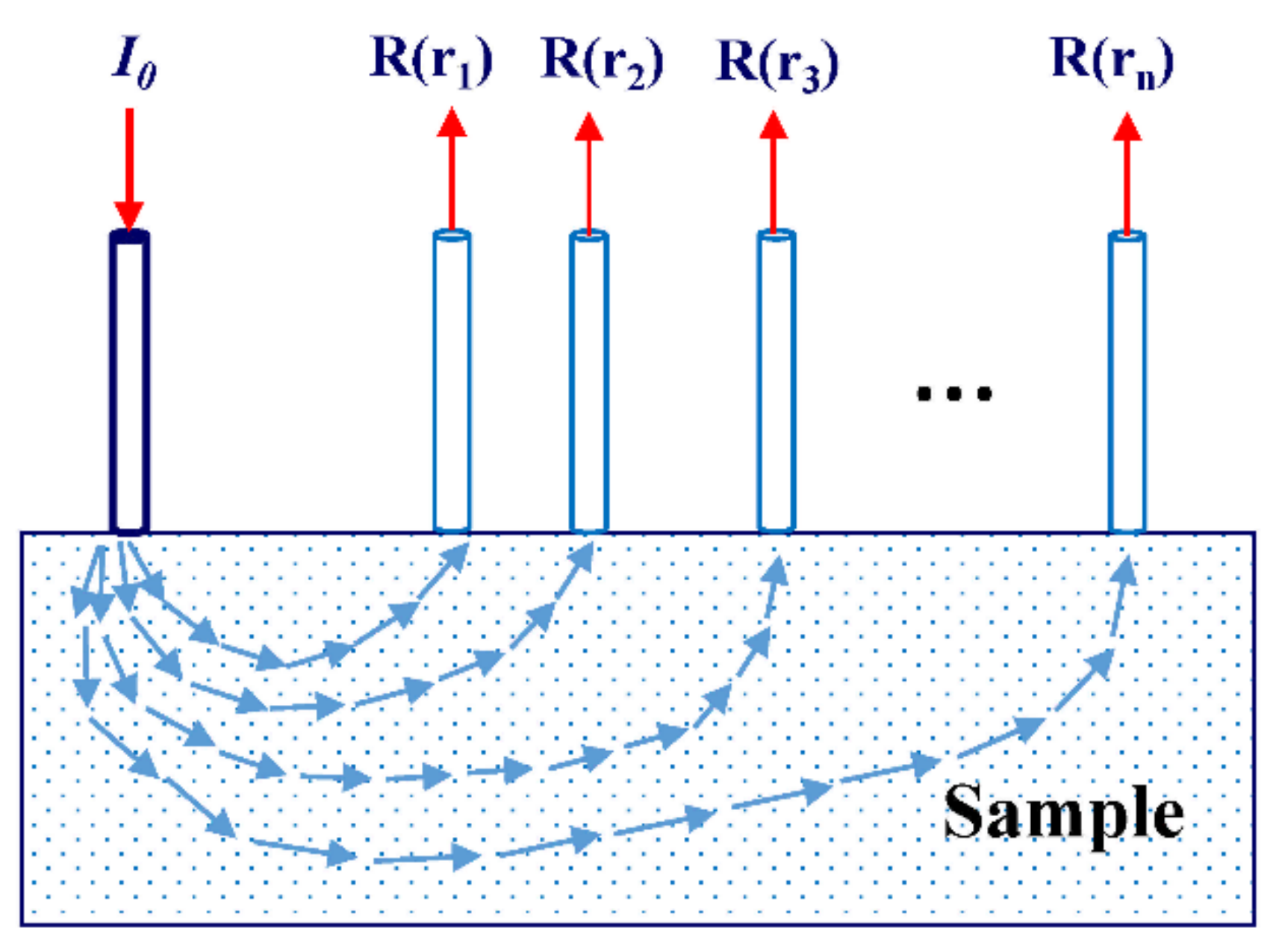

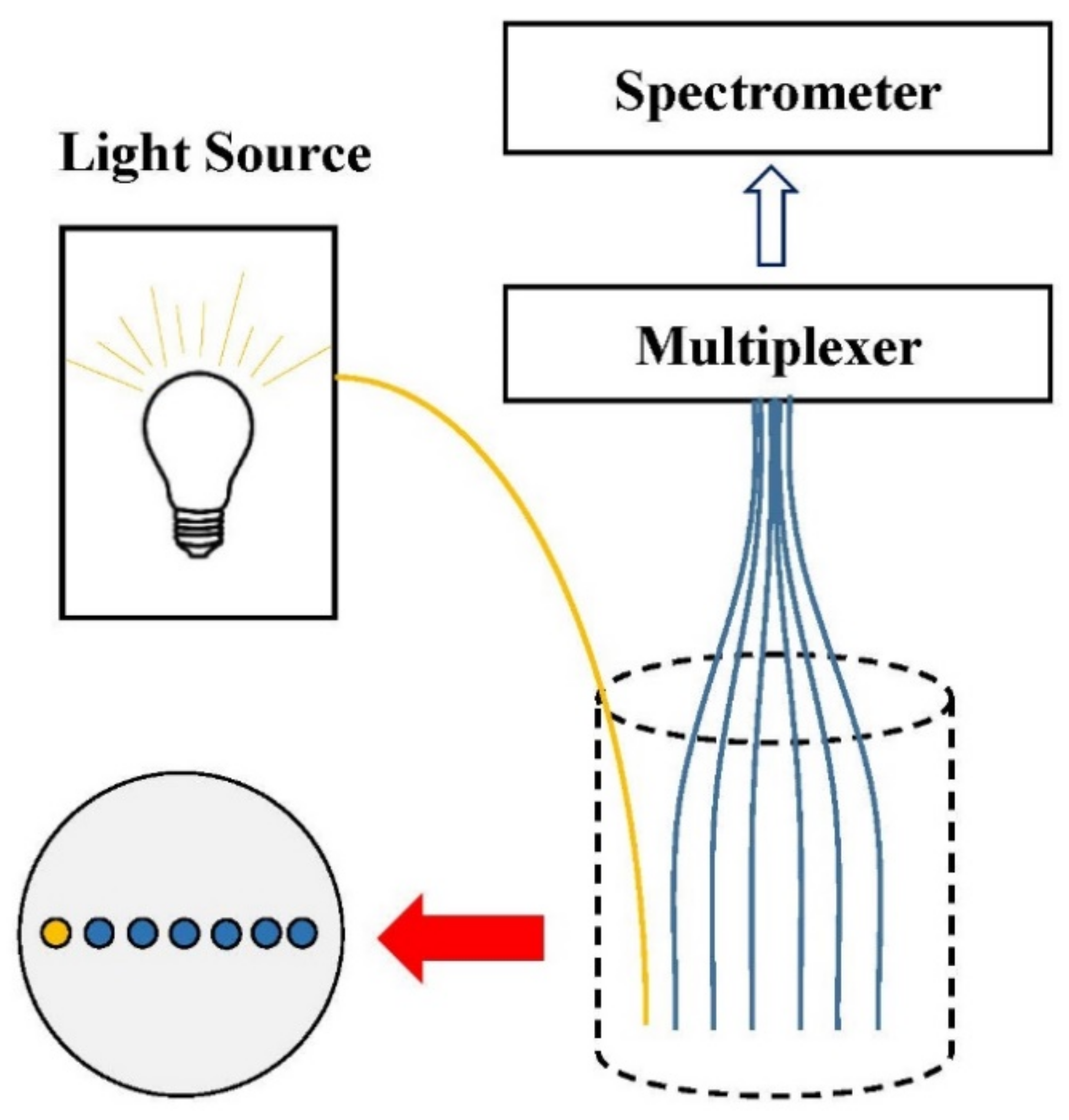
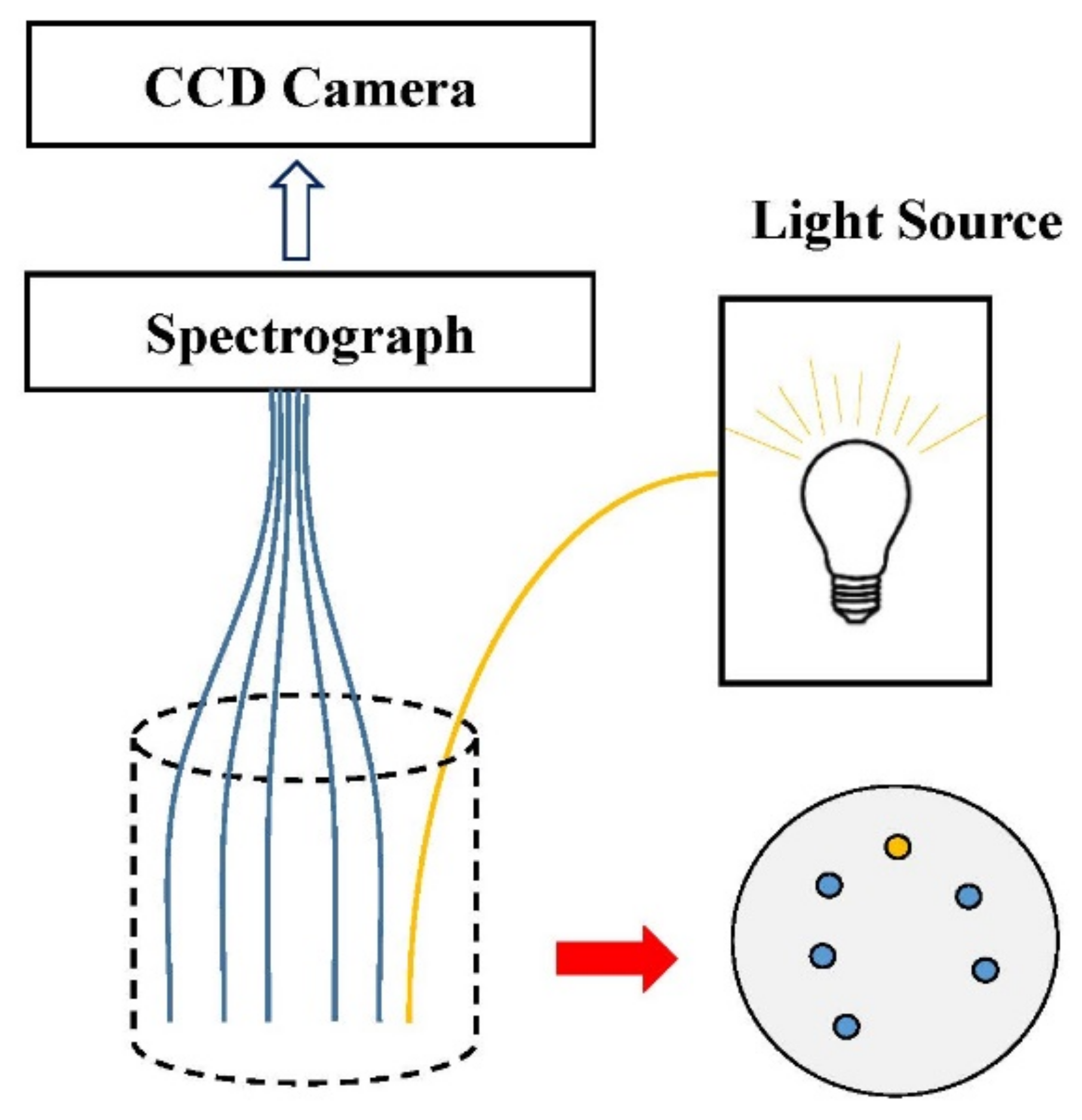
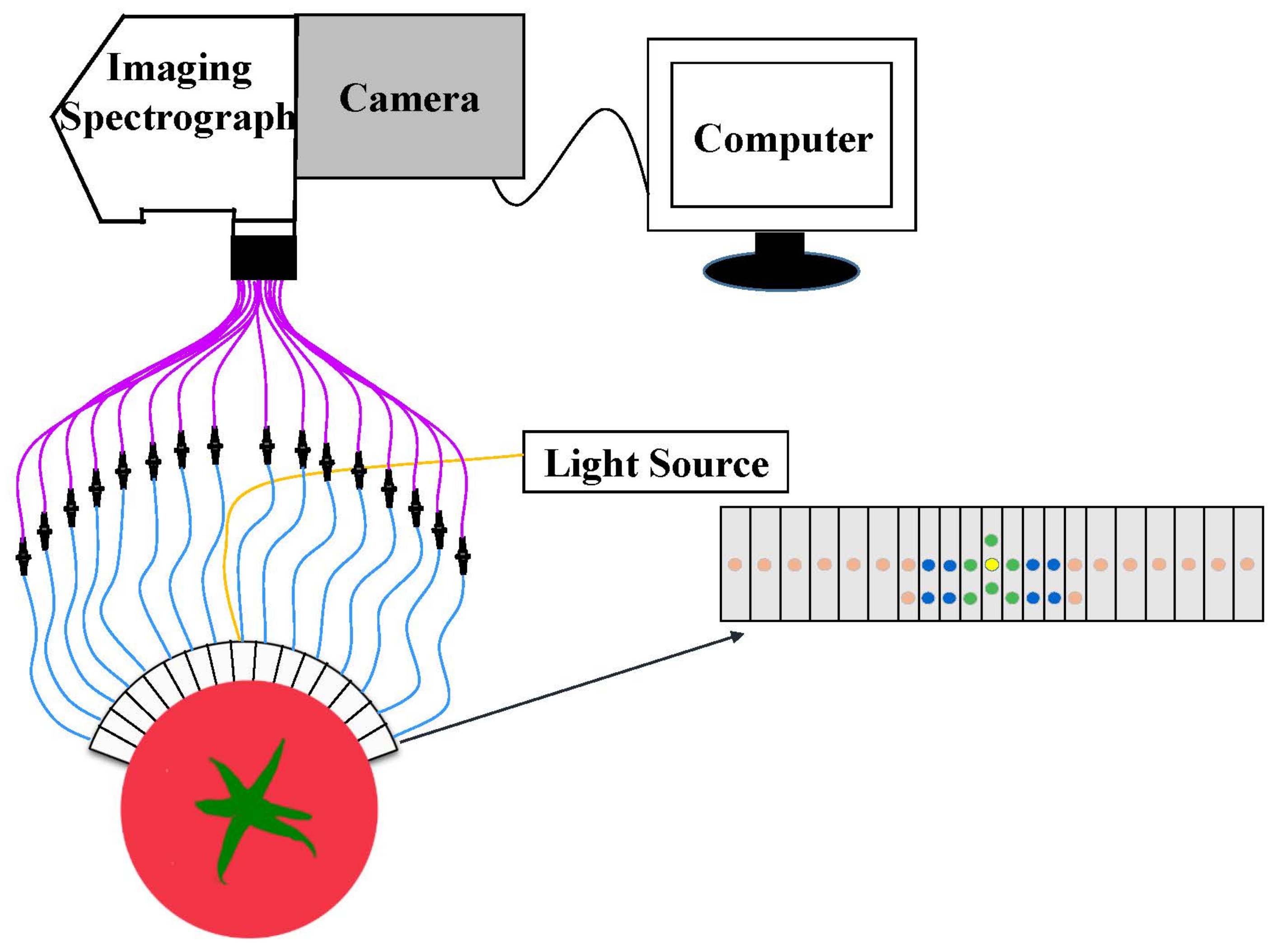
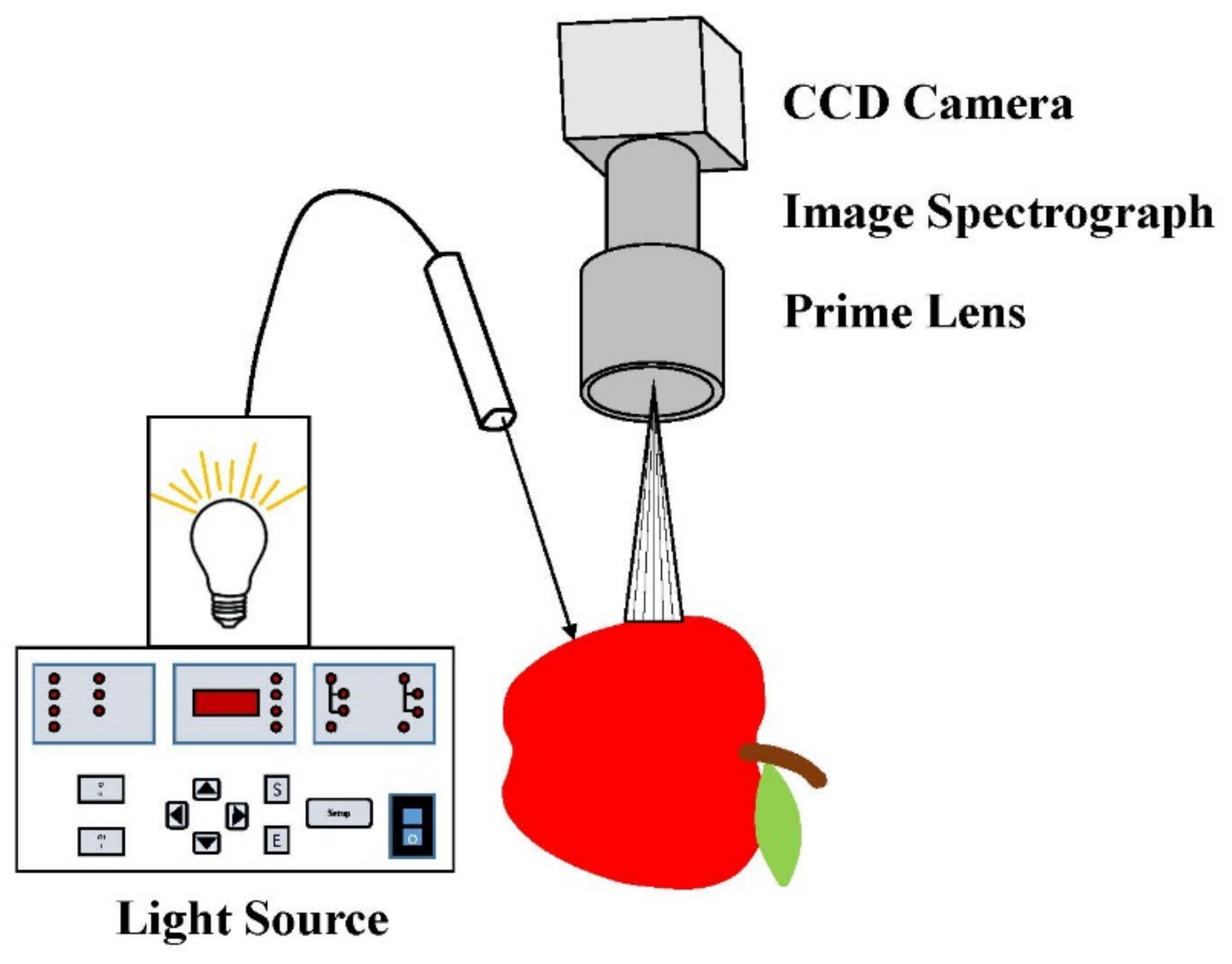
| Configurations | Products | Wavelength (nm) | References |
|---|---|---|---|
| OFA 1 | Apple | 400–1000 | [82] |
| 750 | [65] | ||
| 550–1650 | [68] | ||
| 600–1100 | [64] | ||
| 500–1000 | [62] | ||
| Tomato | 550–1650 | [45,54,63,66,67,69,70,83,84] | |
| Pear | 500–1000 | [85] | |
| HLI 2 | Apple | 500–1000 | [44,75,86,87,88,89] |
| 450–1000 | [71] | ||
| 600–1000 | [90] | ||
| 450–1050 | [91] | ||
| 650, 980 | [92] | ||
| Tomato | 500–1000 | [44] | |
| 500–950 | [77] | ||
| Peach | 500–1000 | [44] | |
| 515–1000 | [76,93] | ||
| 550–1000 | [94,95] | ||
| Cucumber | 700–1000 | [96] | |
| 500–1000 | [44] | ||
| Pear | 500–1000 | [44] | |
| Plum | |||
| Kiwifruit | |||
| Zucchini squash | |||
| Juice | 500–1000 | [97] |
| Products | Quality Attributes | Main Studies | Models | References |
|---|---|---|---|---|
| Apple | Firmness, SSC | Prediction for apple firmness and SSC. | PLS 1 | [82] |
| MLR 2 | [86] | |||
| PLS | [87] | |||
| Mealiness | Investigate the possibility of non-destructive apple mealiness classification. | PCR 3, PLS, ANN 4 | [92] | |
| Bruising | Knowledge of the spectral absorption and scattering properties of normal and bruised apple tissue. | — | [88] | |
| Tissue structure | Research on light penetration properties of ‘Jonagold’ apple tissue. | — | [99] | |
| Investigation on light propagation through apple tissue structures. | — | [100] | ||
| Optical properties–microstructure–texture relationships of dried apple slices. | — | [62] | ||
| Quantify the relationship of optical properties with structural and mechanical properties in apple tissues. | LRA 5 | [75] | ||
| Peach | Firmness, SSC | Prediction of firmness and SSC for ‘Red Star’ peaches. | PLS LS-SVM 6 | [93] |
| Fungal infection | Determine the relationships of the optical parameters with structural and biochemical parameters during quality deterioration. | PCCA 7 | [94] | |
| Bruising | Measure the optical coefficients of peaches after bruising at different maturity levels and detect bruises. | SVM 8 | [95] | |
| Tomato | Maturity | Measure the absorption and scattering coefficients of tomato fruit at four maturity stages. | — | [45,54] |
| Ripeness evaluation and classification of ‘Sun Bright’ tomato. | PLS-DA 9 | [77] | ||
| Firmness, SSC | Prediction for tomato firmness and SSC by optical property parameters. | PLS | [66] | |
| Cucumber | Defect | Measure the optical absorption and scattering properties of normal and internally defective pickling cucumbers. | — | [96] |
| Pear | Optical property | Optical property measurement of pear samples with a double-fiber-optical-probe system. | — | [85] |
| Juice | Optical property | Measure the absorption and scattering properties of turbid food materials. | LRA | [97] |
| Various products | Optical property | Optical property measurement for the samples of apple, peach, pear, kiwifruit, plum, cucumber, zucchini squash, and tomato. Classification of tomato at three ripeness stages. | — | [44] |
| Products | Quality Attributes | Main Studies | Models | References |
|---|---|---|---|---|
| Apple | Firmness, SSC | Simultaneous evaluation of SSC and firmness in apple with a multifiber-based SRS measurement system. | PLS | [64] |
| Evaluate and compare different mathematical models for describing the hyperspectral scattering profiles in order to select an optimal model for predicting firmness and SSC of apples. | MLR | [71] | ||
| Mealiness | Detection and classification of mealy apples for investigating the potential of hyperspectral scattering technique. | PLS | [90] | |
| Bruising | Evaluate the changes of optical properties in tomatoes during ripening and develop classification models for grading the ripeness of tomatoes. | PLS-DA | [77] | |
| Variety classification | Classification of apple varieties based on individual spectra and spectral combination. | PLS-DA | [68] | |
| Sort three varieties of apple into two quality grades based on firmness, SSC, or both firmness and SSC. | LDA 1 | [91] | ||
| Tomato | Maturity | Recognition for tomato surface color and internal color by SRS and conventional single point VIS/NIR spectroscopy. | PLS-DA | [84] |
| Evaluate tomato maturity in different layers by using a newly developed spatially resolved spectroscopic system. | SVM-DA 2 | [67] | ||
| Tomato maturity classification based on different models and source-detector distance. | PLS-DA SVM-DA | [69] | ||
| Firmness, SSC/pH | Quality assessment (SSC and pH) of tomatoes with single-point spectra and SR spectra using a newly developed SRS system. | PLS | [83] | |
| Quality evaluation of tomato fruit based on individual spectra and spectral combination with different source-detector distance. | PLS | [63] | ||
| Determine optimal prediction models for the firmness parameters with individual SR spectra and their combinations. | PLS | [70] |
Publisher’s Note: MDPI stays neutral with regard to jurisdictional claims in published maps and institutional affiliations. |
© 2022 by the authors. Licensee MDPI, Basel, Switzerland. This article is an open access article distributed under the terms and conditions of the Creative Commons Attribution (CC BY) license (https://creativecommons.org/licenses/by/4.0/).
Share and Cite
Si, W.; Xiong, J.; Huang, Y.; Jiang, X.; Hu, D. Quality Assessment of Fruits and Vegetables Based on Spatially Resolved Spectroscopy: A Review. Foods 2022, 11, 1198. https://doi.org/10.3390/foods11091198
Si W, Xiong J, Huang Y, Jiang X, Hu D. Quality Assessment of Fruits and Vegetables Based on Spatially Resolved Spectroscopy: A Review. Foods. 2022; 11(9):1198. https://doi.org/10.3390/foods11091198
Chicago/Turabian StyleSi, Wan, Jie Xiong, Yuping Huang, Xuesong Jiang, and Dong Hu. 2022. "Quality Assessment of Fruits and Vegetables Based on Spatially Resolved Spectroscopy: A Review" Foods 11, no. 9: 1198. https://doi.org/10.3390/foods11091198
APA StyleSi, W., Xiong, J., Huang, Y., Jiang, X., & Hu, D. (2022). Quality Assessment of Fruits and Vegetables Based on Spatially Resolved Spectroscopy: A Review. Foods, 11(9), 1198. https://doi.org/10.3390/foods11091198







